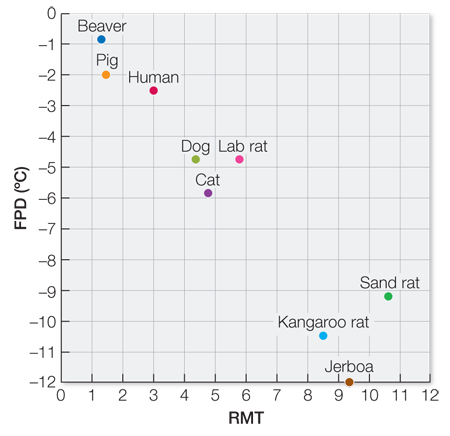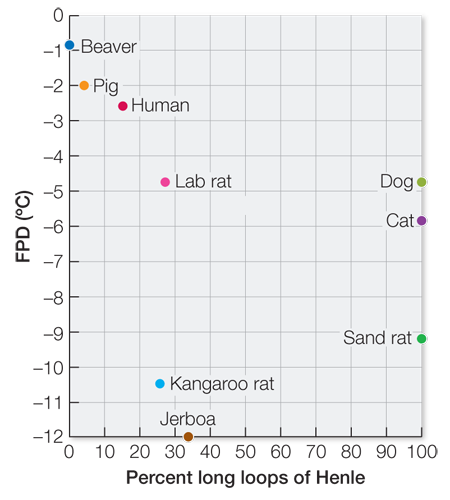Apply What You’ve Learned
Review
51.5 As the tubular fluid passes down the collecting duct, water can be reabsorbed into the extracellular fluid to produce a more concentrated urine in the tubule.
Original Paper: Schmidt-
The ability of a mammalian kidney to produce concentrated urine is directly related to the countercurrent multiplier mechanism found in the loops of Henle. Because of the way this mechanism works, it could be hypothesized that the longer the loops of Henle, the more concentrated the urine can become. Since bigger kidneys should have the longest loops, a large mammal, such as an elephant, should be able to produce much more concentrated urine than a small mammal, like a shrew. However, some of the mammals that live in the driest conditions on Earth are very small. How can these small mammals conserve water by producing highly concentrated urine with such tiny kidneys?
To account for body size, scientists refined their hypothesis by saying that it wasn’t just the total length of the loops of Henle, but the “relative” length compared with the rest of the kidney. The loops of Henle are found only in the medulla of the kidney, so the loops can be only as long as the medulla is thick. To normalize the data across different-
On further study, it was also noticed that in many species not all of the loops of Henle extend the full length of the medulla. Some are shorter than others. This presented a second hypothesis, namely that the ability to concentrate urine could be related to the number of long loops of Henle compared with short loops of Henle. In other words, the higher the percent of long loops to short, the higher the possible concentration of urine.
To gather evidence in support of one hypothesis over the other, scientists performed many measurements on various-
| Animal | Percent long loops of Henle |
RMT | FPD (°C) |
|---|---|---|---|
| Human | 14 | 3 | 2.6 |
| Pig | 3 | 1.6 | 2 |
| Dog | 100 | 4.3 | 4.85 |
| Cat | 100 | 4.8 | 5.8 |
| Beaver | 0 | 1.3 | 0.96 |
| Lab rat | 28 | 5.8 | 4.85 |
| Sand rat | 100 | 10.7 | 9.2 |
| Kangaroo rat | 27 | 8.5 | 10.4 |
| Jerboa | 33 | 9.3 | 12 |
Questions
Question 1
Is the RMT a good predictor of an animal’s ability to concentrate urine? To answer this, plot the RMT versus FPD.
Yes, the RMT is a good predictor of the ability of a species to concentrate its urine.

Question 2
Are animals with a higher percent of long loops of Henle more capable of producing concentrated urine? To answer this, plot the percent long loops of Henle versus FPD.
Although several species with low percentages of long loops cannot produce highly concentrated urine, some with high percentages of long loops have only moderate capacity for producing concentrated urine and three of the species that produce the most concentrated urine have low percentages of long loops. If you calculate a correlation coefficient for these data, it is 0.44, and with a sample size of 7, the p value is 0.32, so this is not a significant correlation.

Question 3
Is the percent of long loops of Henle or RMT the better predictor of an animal’s ability to concentrate urine? Explain your answer.
RMT is a much better predictor of an animal’s ability to produce concentrated urine. As you can see in the percent of long loops of Henle versus FPD plot, animals such as the dog, cat, and sand rat, which have 100 percent long loops of Henle, were unable to produce the high concentrations of urine seen in the kangaroo rat and jerboa. By contrast, in the RMT versus FPD plot, animals with a high RMT, such as the sand rat, kangaroo rat, and jerboa, were able to produce higher concentrated urine than animals with a lower RMT.
Go to LaunchPad for the eBook, LearningCurve, animations, activities, flashcards, and additional resources and assignments.